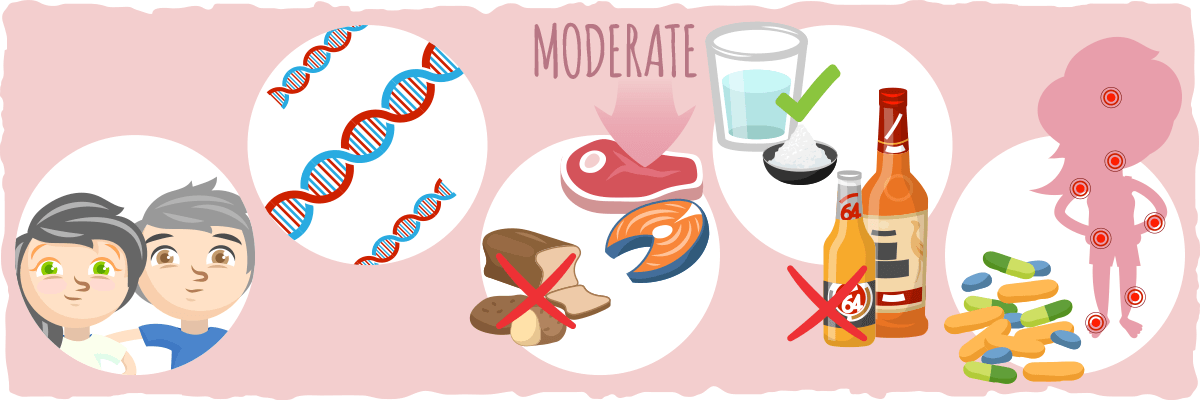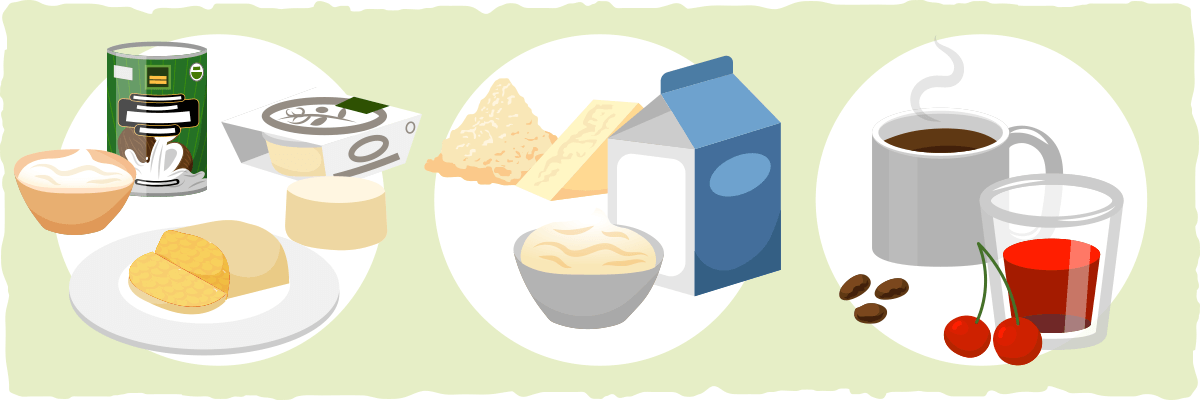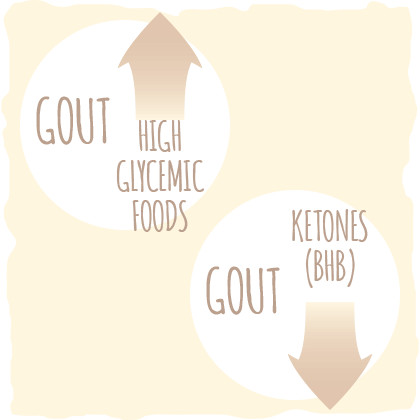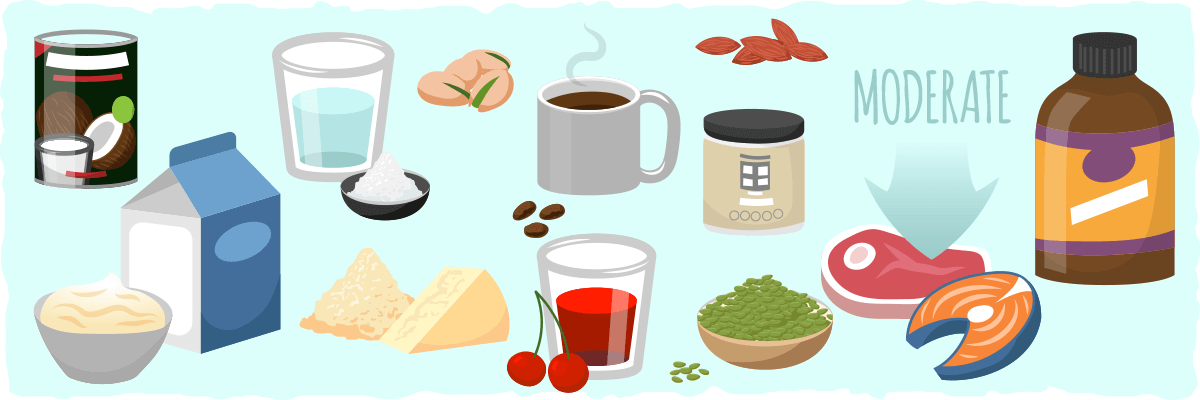Painful joints, swelling, sudden intense pain, these are the hallmarks of gout — a type of arthritis that is caused by the buildup of uric acid. Gout usually affects the joints, particularly the base of the big toe, causing gout attacks of severe pain as well as swelling.
Fortunately, this condition is simple enough that we can easily study the various causes and risk factors for gout and how to potentially alleviate its symptoms. In fact, the current research has found a plethora of simple dietary and lifestyle modifications that can help those who suffer from this debilitating condition.
What is Gout? A Brief Overview
Gout is one of the most common types of arthritis. According to data from 2007-2008, approximately 8.3 million US adults were affected by gout. It is much more common in people who are overweight and/or have metabolic syndrome, which is why the incidence of gout has been increasing over the past decade.
Gout is typically characterized by sudden and painful inflammation of a joint, most often at the base of the big toe. It can also affect other joints, like heels, knees, wrists and finger joints.
The sudden pain and inflammation are provoked by elevated levels of uric acid in the blood, resulting in crystals that deposit themselves in the affected joint. These crystals will then trigger the immune system, causing pain and inflammation.
The Risk Factors for Gout

Many factors have been found to contribute to uric acid build up. Here is a brief look at the most well-researched risk factors:
- Age. Men between 40 and 50 years old and post-menopausal women are more likely to develop gout.
- Gender. Men are more likely than women to develop gout. This may be due to the effect that female sex hormones have on lowering uric acid levels.
- Family history. If you have someone in your family with gout, you may be more likely to develop it as well.
- Diet. Meat and seafood consumption have been found to increase the risk of gout. Diets that provoke high insulin levels (i.e, a high calorie, high carb and sugar diet) will increase gout risk as well.
- Hydration status. Not drinking enough water and/or consuming enough electrolytes can make it more difficult for the body to excrete uric acid.
- Alcohol consumption. Regular alcohol consumption increases the risk of gout. More specifically, alcohol use was found to be associated with a 3-fold higher risk of gout among women and a 2-fold higher risk in men, compared to those with no alcohol intake or ≤1 ounce of alcohol intake per week.
- Medications. Some medications, such as diuretics, cyclosporine, aspirin, and niacin, can put you at risk of gout.
- Other health conditions. High blood pressure, high BMI, kidney disease, thyroid disease, obesity, metabolic syndrome, high cholesterol levels, high triglyceride levels, sleep apnea, and diabetes can all raise your risk of gout.
It is also important to mention the impact that gout has on other markers of health. In general, epidemiological studies have found gout to be independently associated with all-cause mortality and cardiovascular mortality. In other words, if you have this form of arthritis your risk of dying from all causes, especially heart disease complications, increases.
Fortunately, gout can be prevented and reversed — along with the increased risk of mortality — by focusing on the modifiable risk factors such as diet, alcohol consumption, and hydration status.
Modifiable Risk Factors for Gout — Finding the Clues to What You Can Do about It

Many myths about what causes gout attacks have been perpetuated over the years. Some of them, such as the myth that high protein diets cause gout, are based on half-truths, while others, like the belief that dairy consumption causes gout attacks, are not supported by the literature. To dispel these myths, let’s take an in-depth look at the current research data to find the truth behind what modifiable risk factors may cause gout and what we can do about it.
Gout and Protein Consumption
Regarding the popular myth surrounding protein consumption and gout, it looks like there is no association between the two. One study, for example, found that a high-protein Atkins diet didn’t increase uric acid level significantly. A recent meta-analysis confirmed this finding as the data showed that protein intake has no association with uric acid levels.
However, when we look a bit closer at the overall data from meta-analysis, specific protein sources do seem to increase the risk of gout. Fish and meat consumption, in particular, was found to increase the incident risk of gout. On the other hand, plant-based proteins either had no effect on uric acid levels or a protective effect against gout.
To provide us with more specific details, one prospective study found that, for a group of over 40,000 men between the ages of 40 and 75 years of age, each additional daily serving of meat increased the risk of gout by 21% while each extra serving of seafood increased the risk by 7%.
Put in another way, the study found that the people who had 2.5 servings of meat per day versus 0.5 servings of meat per day had a 1.4 times greater risk of developing gout while those who had ~1 serving of seafood per day rather than ~one-tenth of a serving increased their risk of developing gout by 1.5 times. Meanwhile, an increase in vegetable protein intake seemed to have no overall effect on the risk of gout.
Gout and Dairy Consumption
A far more interesting pattern emerges when we look at the data on dairy consumption and gout. You may assume, since dairy contains animal protein, that it is best to avoid it to reduce your risk of gout. However, the complete opposite is true.
Dairy products have been shown to have uric acid lowering and anti-inflammatory properties that directly affect the incidence of gout. For example, one study found that dairy products were protective against gout and another study discovered that all types of milk increase the excretion of uric acid in humans.
Other Food Products that Affect Your Gout Risk
Other dietary factors that have been shown to protect against gout are coffee, vitamin C, vitamin B9 (folate), and cherry juice. Among them, coffee, vitamin C, and cherry juice all have the potential to reduce uric acid levels.
Conversely, dietary factors, other than fish and meat, that have been shown to increase the risk of gout are alcohol, sugar-sweetened soft drinks, and foods high in fructose. Each one of these should be limited or avoided to help alleviate gout symptoms.
Putting it all Together — How Diet Affects Your Risk of Gout
After exploring the data from these studies, the potential for an ideal diet for gout sufferers begins to arise. Perhaps a diet that cuts out the sugar and alcohol, limits meat and seafood intake, and derives most of its protein from plants and dairy would be a good start.
On top of that, consuming coffee, supplementing with cherry juice and high vitamin C and folate foods, and limiting carb intake can help lower uric acid levels and gout risk further.
However, this ideal gout diet is only based on epidemiological data at this point. What happens when we put people on a diet that mimics many of the components of our speculative diet plan?

Dietary Interventions for Gout — What the Clinical Research Says
There is a lack of high-quality clinical trial evidence on whether specific dietary interventions can reduce the risk of recurrent gout attacks, and further studies are required in this field. However, there a couple of studies that we can take a look at.
The first study I could find on dietary interventions for gout sought to find out how different variations of low glycemic index diets affected uric acid levels in both men and women with the mean age of ~52. The findings confirm our understanding that following an insulin-lowering diet will help decrease uric acid levels. However, the decrease in uric acid for the low glycemic index diet groups was only around -0.25 mg/dl.
To put these results into context, normal uric acid values for women are 2.5 to 7.5 mg/dL and for men are 4.0 to 8.5 mg/dL. Whether a 0.25 mg/dL decrease in uric acid will play a major role in preventing gout or not depends on the person.
According to the American College of Rheumatology (ACR), your target level if you have gout is a blood uric acid level of less than 6.0 mg/dL, so making a shift to a lower glycemic index diet may help you reach these levels and alleviate gout symptoms.
But what happens when we take the intervention one step further and follow the lowest glycemic index diet possible?
How the Keto Diet Affects Uric Acid Levels
Due to how severely it restricts carb consumption, the keto diet has the lowest glycemic index of any diet. Short-term studies on this way of eating show a temporary rise in uric acid during the first few weeks. This effect seems to disappear after about six weeks, with uric acid returning to baseline or even lower.
This initial rise in uric acid levels is thought to be caused by an increase in protein breakdown for energy in response to the lack of dietary carbs. Once the body starts burning ketones for fuel, the body’s sugar needs will decrease along with protein breakdown and uric acid levels.
Longer-term studies confirm our mechanistic understanding, showing that there is no significant change in uric acid levels in people doing a low-carb diet over several months to years.

One study even found that uric acid can go down significantly after six months of a low carb diet, suggesting it may decrease the risk of gout.
Altogether, it seems that the keto diet may increase the risk of gout in the first couple of weeks, while potentially reducing the risk as the body burns more ketones for fuel. Anecdotally, I know of many people who reported that the keto diet cured their gout, while others experienced gout-like symptoms after starting the diet (this may be due to many reasons including increased meat and fish consumption and/or a lack of ketone production and keto-adaptation).
Other Things to Consider with the Keto Diet and Gout
A common way to treat gout is by taking NSAIDs to reduce inflammation, losing weight, and limiting food and drinks that increase the risk of gout. Interestingly enough, the keto diet is highly effective at promoting weight loss, reducing inflammation, and cutting out many of the foods and drinks that provoke gout.
What’s also worth noting is the recent discovery that beta-hydroxybutyrate (BHB) — a ketone that our body produces — serves many purposes related to relieving gout symptoms. For example, the current research has found that:
- BHB inhibits IL-1β secretion from neutrophils
- BHB inhibit NLRP3 activation in aged neutrophils
- BHB inhibits both priming and assembly steps of NLRP3 activation in neutrophils
To put it more simply, BHB prevents the activation of many of the inflammatory pathways responsible for gout attacks and gout symptoms. This also means that, since the keto diet stimulates BHB production, it has the ability to alleviate symptoms and prevent gout attacks from occurring.
With that being said, the keto diet can still cause gout symptoms in susceptible individuals who increase their meat and seafood consumption significantly while following the diet. The keto way of eating also doesn’t make you immune to the harmful effects of alcohol consumption and dehydration so these must also be addressed as well.
Practical Application — The Best Diet for Treating Gout?

With our newfound knowledge of the risk factors for gout and the current research data, we have enough information to develop what may be the ideal diet for those who suffer from gout.
From a macronutrient perspective, a low carb, calorie-restricted diet would probably be best especially if the carbs are limited enough to increase ketone production. The diet should also feature plant foods and dairy as its primary protein sources while limiting fish and meat consumption.
All alcohol should be avoided, and coffee, folate, vitamin C, cherry juice can be supplemented with to reduce the likelihood of gout attacks further. MCT oil and BHB ketone supplements may also be helpful due to the fact that they can help inhibit the inflammatory processes that trigger gout symptoms.
Maintaining proper hydration and electrolyte levels are essential as well, especially if you are following a keto diet and/or exercising regularly.
Altogether, here is a quick outline for what may be the best diet for gout:
- Follow a keto diet that allows you to maintain ketosis and lose excess fat.
- Limit your meat intake to ~5.5 or fewer servings per week
- Limit your seafood intake to ~1 or fewer servings per week
- Get most of your protein from high-fat dairy products and plant-based keto-friendly sources
- Avoid alcohol consumption
- Drink plenty of water and consume plenty of electrolytes (for precise recommendations, check out the relevant sections in this guide)
- Eat plenty of low carb vegetables to get enough vitamin C and folate.
- Drink Ketoproof Coffee to start your day.
- Supplement with vitamin C, folate, BHB salts, MCT oil, and/or cherry juice if necessary (however, don’t drink so much cherry that you exceed your daily carb limit and impair ketone production).
- Exercise regularly, sleep at least 7-9 hours a night, and incorporate stress-relieving practices into your daily schedule.
Sources:
- Gout — American College of Rheumatology
- Gout: a review of non-modifiable and modifiable risk factors — NCBI
- Association Between Gout and All-Cause as well as Cardiovascular Mortality: A Systematic Review — NCBI
- Purine-Rich Foods, Dairy and Protein Intake, and the Risk of Gout in Men — The New England Journal of Medicine
- Education and non-pharmacological approaches for gout. — NCBI
- Uric Acid Test (Blood Analysis) — Healthline
- Risk Factors for Gout and Prevention: A Systematic Review of the Literature — NCBI
- Prevalence of gout and hyperuricemia in the US general population: The National Health and Nutrition Examination Survey 2007–2008 — Wiley Online Library
- Effect of sex hormones on uric acid metabolism in rats. — NCBI
- Menopause, Postmenopausal Hormone Use and Risk of Incident Gout — NCBI
- Steve Phinney and Richard Johnson: Ketones, Uric Acid, High Fat and Health — Me And My Diabetes
- A Low-Carbohydrate as Compared with a Low-Fat Diet in Severe Obesity — The New England Journal of Medicine
- Systematic review and meta‐analysis of clinical trials of the effects of low carbohydrate diets on cardiovascular risk factors — Wiley Online Library
- High-Protein Diet (Atkins Diet) and Uric Acid Response — American College of Rheumatology
- Effects of Lowering Glycemic Index of Dietary Carbohydrate on Plasma Uric Acid: The OmniCarb Randomized Clinical Trial — NCBI
- β-hydroxybutyrate deactivates neutrophil NLRP3 inflammasome to relieve gout flares — NCBI
